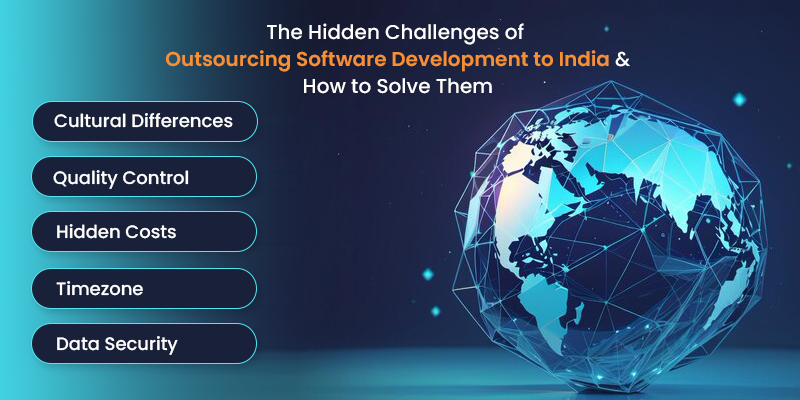The Hidden Challenges of Outsourcing Software Development to India & How to Solve Them
In today’s fast-paced digital landscape, outsourcing software development to India has become a go-to strategy for many US-based startups, SMEs, and mid-scale businesses. The appeal? Cost savings, access to a skilled workforce, and faster development cycles. However, while outsourcing offers numerous benefits, it also presents challenges that can impact project success if not managed properly.
If you’re considering outsourcing your software development to India, it’s crucial to understand and address potential hurdles upfront. In this guide, we’ll explore the most common outsourcing challenges and provide actionable solutions to ensure a smooth and successful partnership with an Indian IT firm.
Challenge #1: Communication Barriers & Time Zone Differences
The Problem:
One of the most common concerns businesses face when outsourcing is communication issues due to time zone differences and language barriers. Delayed responses, misinterpretations, and lack of real-time collaboration can slow down project progress.
The Solution:
- Use Collaboration Tools: Platforms like Slack, Zoom, Microsoft Teams, and Trello can bridge the communication gap.
- Define Overlapping Work Hours: Ensure at least 2-3 hours of overlapping time for live discussions and quick decision-making.
- Regular Stand-Up Meetings: Daily or weekly sync-up meetings keep both teams aligned on progress and challenges.
- Clear Documentation: Use tools like Confluence or Notion to document requirements, updates, and SOPs to avoid misunderstandings.
Challenge #2: Quality Control & Code Consistency
The Problem:
Not all Indian outsourcing firms maintain high-quality coding standards, leading to issues such as bug-ridden software, inefficient code, and maintainability problems. Many businesses fear that outsourcing means compromising on quality.
The Solution:
- Conduct Technical Evaluations: Before selecting a vendor, review their past work, GitHub repositories, and coding practices.
- Enforce Code Reviews: Implement peer reviews, CI/CD pipelines, and automated testing to maintain high-quality code.
- Use Agile Development: Ensure your outsourcing partner follows Agile methodologies to allow continuous iterations and improvements.
- Request Proof of Work: Ask for case studies, client testimonials, and sample projects before signing a contract.
Challenge #3: Data Security & Intellectual Property Risks
The Problem:
Handling sensitive customer data and proprietary business information can be risky when working with an overseas IT provider. Concerns over data breaches, IP theft, and non-compliance with global security standards can be major roadblocks.
The Solution:
- Sign NDAs & SLAs: Always sign a Non-Disclosure Agreement (NDA) and a Service Level Agreement (SLA) to legally protect your data.
- Ensure Compliance Standards: Choose vendors who adhere to GDPR, SOC2, HIPAA, or ISO 27001 security frameworks.
- Use Secure Development Environments: Ensure your outsourcing partner uses encrypted connections, VPNs, and access control policies.
Challenge #4: Hidden Costs & Budget Overruns
The Problem:
Many businesses outsource to save costs, but hidden expenses like scope creep, additional revisions, infrastructure fees, or extended timelines can increase the actual project cost.
The Solution:
- Define a Clear Scope of Work: Ensure all requirements are documented in a detailed contract to avoid scope creep.
- Choose the Right Pricing Model:
- Fixed Price: Best for well-defined projects with clear deliverables.
- Time & Material: Ideal for flexible and evolving projects.
- Dedicated Teams: Perfect for long-term engagements with ongoing development needs.
- Set Up Milestone Payments: Pay in phases based on deliverables instead of lump-sum payments to mitigate risk.
Challenge #5: Cultural Differences & Work Ethic Misalignment
The Problem:
Different work cultures, decision-making styles, and expectations can lead to misunderstandings and delays in project execution.
The Solution:
- Understand Cultural Nuances: Encourage cross-cultural training sessions between teams.
- Clarify Work Expectations: Establish well-documented SOPs and project guidelines upfront.
- Encourage Open Feedback: Foster an environment where both teams feel comfortable sharing concerns and suggestions.
The Future of IT Outsourcing to India
Despite these challenges, India remains a top outsourcing destination due to: ✔ A massive talent pool of skilled developers. ✔ Competitive pricing compared to US-based teams. ✔ Adoption of cutting-edge technologies like AI, Blockchain, and Cloud Computing. ✔ A growing number of IT firms that focus on quality, compliance, and innovation.
By choosing the right outsourcing partner, setting clear expectations, and implementing strategic measures, businesses can leverage India’s tech expertise while overcoming common outsourcing pitfalls.
Final Thoughts: Should You Outsource to India?
Yes, if: You want cost-effective, high-quality software development with the right outsourcing strategy in place. No, if: You don’t have clear project requirements or lack proper vendor evaluation methods.
At QuickSoftec, we specialize in helping US-based startups, SMEs, and mid-sized businesses seamlessly outsource their software development needs to India. With a proven track record, strong security policies, and an Agile-driven approach, we ensure risk-free outsourcing experiences.
Need expert guidance? Let’s discuss your project today!

